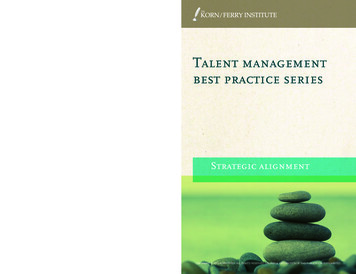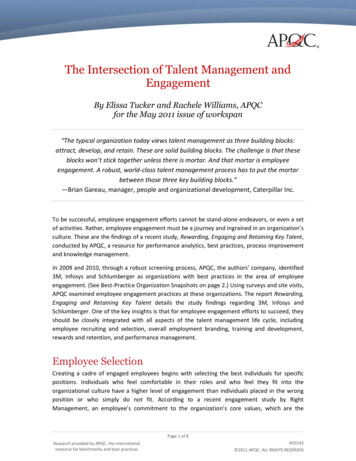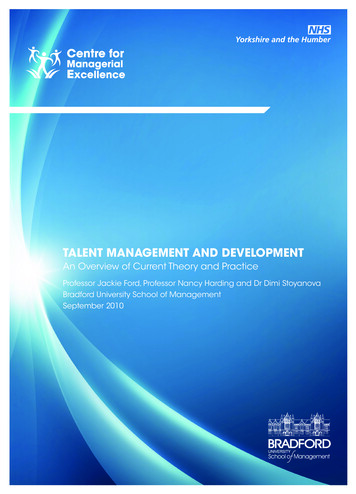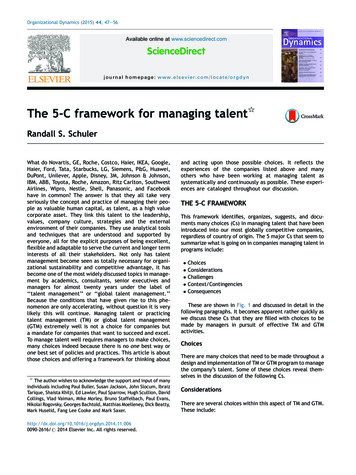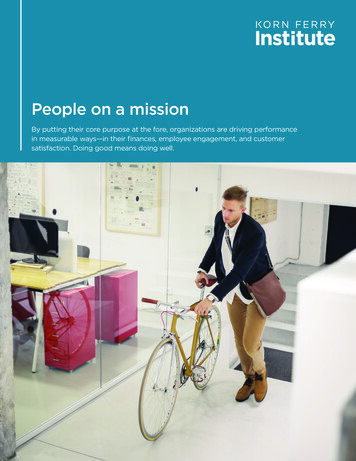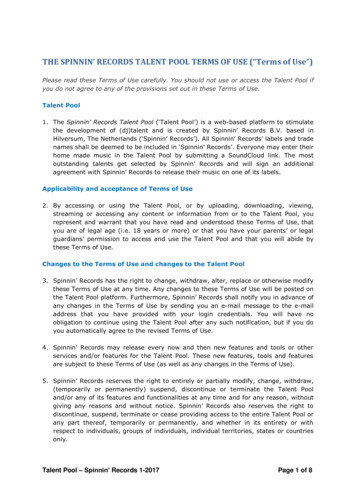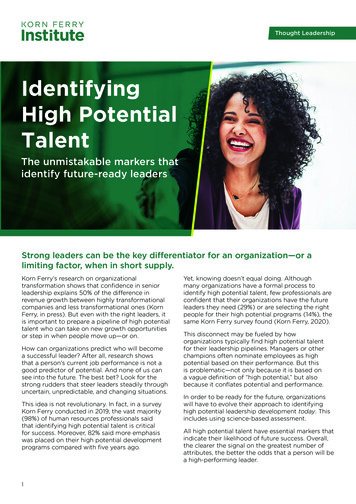
Transcription
Thought LeadershipIdentifyingHigh PotentialTalentThe unmistakable markers thatidentify future-ready leadersStrong leaders can be the key differentiator for an organization—or alimiting factor, when in short supply.Korn Ferry’s research on organizationaltransformation shows that confidence in seniorleadership explains 50% of the difference inrevenue growth between highly transformationalcompanies and less transformational ones (KornFerry, in press). But even with the right leaders, itis important to prepare a pipeline of high potentialtalent who can take on new growth opportunitiesor step in when people move up—or on.How can organizations predict who will becomea successful leader? After all, research showsthat a person’s current job performance is not agood predictor of potential. And none of us cansee into the future. The best bet? Look for thestrong rudders that steer leaders steadily throughuncertain, unpredictable, and changing situations.This idea is not revolutionary. In fact, in a surveyKorn Ferry conducted in 2019, the vast majority(98%) of human resources professionals saidthat identifying high potential talent is criticalfor success. Moreover, 82% said more emphasiswas placed on their high potential developmentprograms compared with five years ago.1Yet, knowing doesn’t equal doing. Althoughmany organizations have a formal process toidentify high potential talent, few professionals areconfident that their organizations have the futureleaders they need (29%) or are selecting the rightpeople for their high potential programs (14%), thesame Korn Ferry survey found (Korn Ferry, 2020).This disconnect may be fueled by howorganizations typically find high potential talentfor their leadership pipelines. Managers or otherchampions often nominate employees as highpotential based on their performance. But thisis problematic—not only because it is based ona vague definition of “high potential,” but alsobecause it conflates potential and performance.In order to be ready for the future, organizationswill have to evolve their approach to identifyinghigh potential leadership development today. Thisincludes using science-based assessment.All high potential talent have essential markers thatindicate their likelihood of future success. Overall,the clearer the signal on the greatest number ofattributes, the better the odds that a person will bea high-performing leader.
Thought LeadershipDrawing on our databases and expertise, KornFerry refined our understanding of what theseattributes are (Korn Ferry, 2018–2019). Wemeasure 18 qualities that are strong indicators ofleadership potential, falling into these six key areas: Leadership Traits: The building blocks of whowe are Learning Agility: The willingness and ability tolearn from experience Drivers of Leadership: Key motivators thatpropel us Key Experiences: A track record ofdevelopmental roles, assignments, andchallenges Capacity for Problem Solving: The aptitudefor logic and reasoning Managed Derailment Risks: The awareness andmitigation of potential risk factors2Copyright 2020 Korn Ferry. All rights reserved.
Thought LeadershipLeadership Traits: The buildingblocks of who we areAll of us are disposed to behave in certain ways.We have underlying tendencies or preferencesthat inform our actions and decisions. Thesepersonality traits are part of our identity, helpingto define who each of us is Extroverts tend to seeksocial engagement. People who are achievementoriented are likely to set very challenging goals.And people with high leadership potential show atendency to act like leaders.The more a person’s traits align with what isrequired for leadership success, the greaterthe potential for superior performance in thefuture. Senior leaders stand out in terms of theirAssertiveness, Tolerance of Ambiguity, Optimism,and Persistence (see Figure 1). So, when identifyinghigh potential, organizations should pay closeattention to these traits. People early in their careermay show they can take charge, are comfortablewith uncertainty, remain upbeat despite setbacks,and continue to pursue long-term goals. These areall signs that they will excel as leaders, given theright opportunities to develop.Figure 1. Senior leaders stand out in terms of their Assertiveness, Tolerance of Ambiguity, Optimism, and Persistence.Copyright 2020 Korn Ferry. All rights reserved.3
Thought LeadershipLearning Agility: The willingnessand ability to learn from experienceWhen one considers what it will take to leadorganizations into the future, the ability to navigatethe uncertainties and complexity of the globalizedeconomy looms large. To succeed, leaders will haveto tackle the new, never-before, and yet-unknown,while also driving positive results.Responsibilities change as people move frombeing individual contributors to helping otherscontribute. There is a further shift as peopleprogress to leading strategically. They tacklemore complex problems with broader scope, andincreasingly work through others to get results.And as the scope of work expands, they take onnew, more complex opportunities—ones theymust handle effectively for their organizations tothrive.Learning agility—the willingness and ability tolearn from experience—is essential to succeedingin new conditions. It helps people extract lessonsfrom their experiences and effectively apply thoselessons to unfamiliar situations. It’s no surprise,then, that learning agility is a core asset ofleadership—and consequently, the facets of agilityare key markers of potential.Study after study has underscored the importanceof learning agility to leaders. Not only are leaderswho are more agile more engaged in their currentroles (Korn Ferry, 2019), but also average levelsof learning agility increase with each level in theFacets of Learning AgilityPeople with high Mental Agility are inquisitiveand enjoy tackling new, complexchallenges. People Agility are insightfulabout interpersonal situations andadept at getting things done withand through others. Change Agility relish change,exploring possibilities, andbuilding new approaches. Results Agility overcomeobstacles and deliver results onchallenging stretch assignments. Situational Self-Awareness focuson the present with awareness ofthe impact people have on them(and vice versa), adjusting theirapproach in new situations.organization (see Figure 2). What’s more, researchshows that learning agility predicts learning andperformance (Laxson, 2018), as well as promotionrate and salary growth (Dai, De Meuse, & Tang,2013). And organizations with highly agileexecutives have 25% higher profit margins thantheir peer group (Swisher & Dai, 2014).Figure 2. Scores across leadership levels for Mental Agility, People Agility, Change Agility, Results Agility, andSituational Self-Awareness.4Copyright 2020 Korn Ferry. All rights reserved.
Thought LeadershipDrivers of Leadership:Key motivators that propel usTalk to mid-level managers, and you will quicklydiscover many are happy where they are, with nodesire to move to roles at higher levels (“There isno amount of money that would get me to takemy boss’s job.”). You also will discover many whowould do the work even if you didn’t pay them (“Ilove this job. I can’t believe they pay me to do it.”).Drivers are the preferences, values, and motivationsthat shape professional aspirations. They help usanswer questions around what we find rewardingand important. People with leadership potentialfind the role of a leader interesting and the workof leading motivating and fun, which is crucial tosuccess. Leadership becomes progressively morechallenging at every level, and the demands ontime and energy increase. If the work doesn’t alignto what drives them, it is unlikely that any leaderwill have the energy and resilience needed tothrive—or even survive.People with less leadership potential typically citethe perks of the role (think title, pay, prestige) astheir primary drivers. High potential leaders, on theother hand, cite the nature of the work as whatdrives them: the opportunity to make a difference(Challenge), to work with their co-workers toachieve shared goals (Collaboration), and to havegreater scope of responsibility (Power). And asleadership rank increases, the average scores forChallenge, Collaboration, and Power do as well(see Figure 3).Figure 3. Three drivers stand out for senior leaders: Challenge, Collaboration, and Power.Copyright 2020 Korn Ferry. All rights reserved.5
Thought LeadershipKey Experiences: A track record ofdevelopmental roles, assignments,and challengesNew experiences are at the heart of learningto lead, making them an important marker ofpotential. Key career experiences build theabilities of high-performing leaders, and the moredevelopmental experiences leaders accumulate,the greater the likelihood they will succeed afterpromotion to the next level.Two types of experiences stand out: KeyChallenges and Perspective. Key Challenges arecritical stretch assignments that allow people tohandle responsibilities with “heat,” often with broadscope, high visibility, substantial ambiguity, and asignificant risk of failure. These assignments offerdeep developmental opportunities that get peopleout of their comfort zones and into unfamiliarterritory (think managing a turnaround, leadingduring a crisis, heading a start-up). Perspective,on the other hand, involves experiences working invarious settings (think different industries, differentfunctions, different countries). These diverseencounters expose people to different knowledge,approaches, and ways of getting results.A leader who is behind the curve, who lacks one ormore relevant experiences, will have to learn theselessons while they are also learning the job. Thisextra demand, at a time of rapid change, makesthe transition risky and more likely to go awry.Too much challenge can hinder performance anddevelopment (Hezlett, 2016), illustrating the valueof having the right experiences at the right time.Figure 4. Scores on Key Challenges and Perspective tend to increase as leadership levels increase.6Copyright 2020 Korn Ferry. All rights reserved.
Thought LeadershipCapacity for Problem Solving:The aptitude for logic and reasoningThe research is clear: High performing leadersare effective analytical and conceptual thinkers(Judge, Colbert, & Ilies, 2004). They spot patternsand trends in data that others miss. And they solveproblems adeptly—first individually, and then asleaders—by marshaling and focusing resources onthe right challenges.But there is an important consideration assomeone progresses in leadership: a person’s rolechanges from being the primary problem solverto ensuring that the problem gets solved. Leaderswho are able to shift out of individual problemsolving mode and into the job of coaching othersto analyze problems will be more likely to succeedin senior leadership roles.Likewise, organizations that rely on individualproblem-solving as their sole or even primaryindicator of high leadership potential risk floodingtheir pipeline with people who will peak in midlevel roles. For this reason, it’s risky to assessa person’s capacity to solve problems withoutalso considering how this ability is deployed in aleadership role.Copyright 2020 Korn Ferry. All rights reserved.7
Thought LeadershipManaged Derailment Risks:The awareness and mitigation ofpotential risk factorsA perennial topic for the cover of businessmagazines is the high-level leader who selfdestructs, sometimes ruining not just their career,but also sabotaging the entire organization.The higher the job level, the greater the risk ofderailment. Expectations are higher and theconsequences of failure can have far-reachingimpact. At the same time, some behaviors don’tbecome a career risk until a leader reaches ahigher-level position.Organizations are infamous for tolerating “quirkybut high-producing” sales representatives or“eccentric but brilliant” professionals in technicalroles. But these positions depend almost entirelyon individual performance. Success as a leader,on the other hand, stems from the energy andcommitment of the people being led.What may be tolerated in a high-performingindividual contributor can undermine trust in andwillingness to follow a leader—and therefore, beconsiderably more damaging. For these reasons,it is imperative that both organizations and highpotential leaders understand and manage thepotential hazards associated with derailment risks.Careful assessment of derailment risks offersinsight into propensities that may cause troublefor otherwise successful leaders, particularlywhen they face stressful, ambiguous, or complexsituations. People who are highly Volatile may beeasily provoked or rattled when stressed. Thoseknown for Micro-Managing may monitor work tooclosely, giving people too little say over how theywork. And people who are Closed may tend todismiss different perspectives and be rigid in theirapproaches to work (see Figure 6).Derailment risks are not fate. Some people whoscore high on derailment risks may not experiencesituations that trigger potentially problematicbehaviors. Others equipped with early awarenessof these risks may develop and deploy strategies tomitigate the possible issues. Derailment risks offerpowerful insights for proactive development andrisk management.Figure 5. Scores across leadership levels for Volatile, Micro-Managing, and Closed.8Copyright 2020 Korn Ferry. All rights reserved.
Thought LeadershipConclusionMany factors—retirements, organizational growth,new strategic challenges, restructuring—fuel theneed to identify and cultivate a pipeline of talent.Identifying high potential talent early, then, lets anorganization deliberately develop future leadersso that when a need arises, someone with therequisite ability is prepared to step up to thechallenge. This is the only truly proactive way tomanage a talent pipeline.mold. That’s why we recommend organizationstake a methodical and objective approach toassessing potential in conjunction with their talentreviews: to increase accuracy and remove bias.What, after all, is the other option? Wait and seewho has the skills to succeed only after they’vestepped into leadership, then replace them if theyfail? This is time consuming, expensive, and fraughtwith pitfalls.Those without the traits of leaders will haveto work even harder to manage the stress ofleadership. Those who aren’t agile learners won’ttake away valuable lessons from their experiences.Those who don’t have the drivers for leadershipwill find their jobs draining rather than energizing.Those short on key experiences won’t hit theground running. Those with high derailment riskswill need to dedicate time to evading challengesor learning workarounds. And those who aren’tquick to reason out solutions with their teams willstruggle to be effective.To succeed in this hyperdemanding, hyperchangingworld, having the right leaders at the right timebecomes a key differentiator. Yet, only 13% of HRprofessionals surveyed reported using sciencebased assessment to identify high potential talent(Korn Ferry, 2020). This is a miss for the rest,particularly because the science of assessing forhigh potential continues to advance.Our research has honed what we know about thekey attributes that drive success—and those traits,drivers, experiences, and agilities are clear. Findhigh potential talent who are motivated to lead,can learn from experience, have a knack for solvingproblems, and are ready to tackle derailment risks,and you’ve found those people on the fast track tobecoming high-performing leaders.High potential employees can sometimes hide inplain sight. Or they may not fit a preconceivedOr, put another way: he leaders you needtomorrow are right in front of you today.Copyright 2020 Korn Ferry. All rights reserved.9
Thought LeadershipReferencesAuthorsDai, G., De Meuse, K. P., & Tang, K. Y. (2013).The role of learning agility in executive careersuccess: The results of two field studies. Journal ofManagerial Issues, 25(2), 108–131.J. Evelyn OrrVP, COO, Korn Ferry InstituteSarah HezlettSenior Director, Korn Ferry InstituteHezlett, S. A. (2016). Enhancing experience-drivenleadership development. Advances in DevelopingHuman Resources, 18(3), 369–389. https://doi.org/10.1177/1523422316645887Judge, T. A., Colbert, A. E., & Ilies, R. (2004).Intelligence and leadership: A quantitative reviewand test of theoretical propositions. Journal ofApplied Psychology, 89(3), 542–552. https://doi.org/10.1037/0021-9010.89.3.542Korn Ferry (2020, February 4). Less than a thirdof HR professionals are confident they have theright leaders for the future. -a-third-of-hrprofessionals-are-confidentKorn Ferry (2018-2019). Korn Ferry Assess –Potential Solution: Leadership potential reportresearch guide and technical manual. Korn Ferry.Korn Ferry (in press). Organizationaltransformation research guide and technicalmanual. Korn Ferry.Laxson, E. N. (2018). Within and betweenperson effects of learning agility: A longitudinalexamination of how learning agility impacts futurecareer success. (Doctoral dissertation). Retrievedfrom Mountain Scholar Digital Collectionsof Colorado & Wyoming. https://hdl.handle.net/10217/191318Swisher, V., & Dai, G. (2014). The agile enterprise:Taking stock of learning agility to gauge the fit ofthe talent pool to the strategy. Korn Ferry.10Copyright 2020 Korn Ferry. All rights reserved.
Thought LeadershipAbout Korn FerryKorn Ferry is a global organizational consulting firm. Wework with organizations to design their organizationalstructures, roles, and responsibilities. We help them hire theright people and advise them on how to reward, develop,and motivate their workforce. And, we help professionalsnavigate and advance their careers.About the Korn Ferry InstituteThe Korn Ferry Institute, our research and analytics arm,was established to share intelligence and expert pointsof view on talent and leadership. Through studies, books,and a quarterly magazine, Briefings, we aim to increaseunderstanding of how strategic talent decisions contributeto competitive advantage, growth, and success.Copyright 2020 Korn Ferry. All rights reserved.11
identify high potential talent, few professionals are confident that their organizations have the future leaders they need (29%) or are selecting the right people for their high potential programs (14%), the same Korn Ferry survey found (Korn Ferry, 2020). This disconnect may be fueled by how organizations typically find high potential talent
